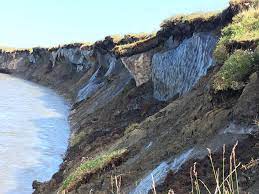Permafrost : Study

Permafrost in the Arctic could release radon, a radioactive gas that has the potential to cause cancer, scientists have warned.
- Radon is a radioactive gas that forms naturally when uranium, thorium, or radium, which are radioactive metals, break down in rocks, soil, and groundwater.
- It is an inert, colourless, and odourless gas.
- Radon gas usually exists at very low levels outdoors, but the gas can accumulate in areas without adequate ventilation, such as underground mines.
Permafrost:
- Permafrost is any ground—from soil to sediment to rock—that has been frozen continuously for a minimum of two years and as many as hundreds of thousands of years.
- It can extend down beneath the earth’s surface from a few feet to more than a mile, covering entire regions, such as the Arctic tundra, or a single, isolated spot, such as a mountaintop of alpine permafrost.
- Although the ground is frozen, permafrost regions are not always covered in snow.
- They can be found on land and below the ocean floor.
- It is found in areas where temperatures rarely rise above freezing point.
- They are most common in regions with high mountains and in Earth’s higher latitudes—near the North and South Poles.
- Permafrost is found almost exclusively in the far northern reaches and high elevations of the Northern Hemisphere, in places like Siberia, Alaska, the Canadian Arctic, Greenland, and the Tibetan Plateau.
- Permafrost is made of a combination of soil, rocks, and sand that are held together by ice. The soil and ice in permafrost stay frozen all year.




